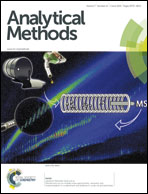Preparation and application of a novel mixed-mode monolith for reversed-phase and per aqueous capillary electrochromatography†
Abstract
A novel mixed-mode monolithic stationary phase based on bonding of 4,5-imidazoledicarboxy acid to the surface of an organic-silica hybrid monolith was prepared and characterized. Satisfactory characteristics in terms of mechanical stability, permeability and reproducibility of the resultant monolithic column were achieved. A typical per aqueous chromatographic behavior was observed in water-rich mobile phases. The resultant monolithic column was applied for the efficient resolution of various polar and hydrophilic compounds under per aqueous or reversed-phase chromatographic conditions, which successfully demonstrated its suitability for the analysis of these polar compounds in highly aqueous mobile phases. The highest column efficiency obtained for the amines was 149 000 N m−1. The experimental results showed that the mixed-mode mechanism of hydrophobic and ion-exchange interactions was involved in the separation under the given conditions. The successful applications suggested that the mixed-mode organic-silica hybrid monolithic column could offer a wide range of retention behaviors and flexible selectivities toward polar compounds, achieving various target separations.


 Please wait while we load your content...
Please wait while we load your content...